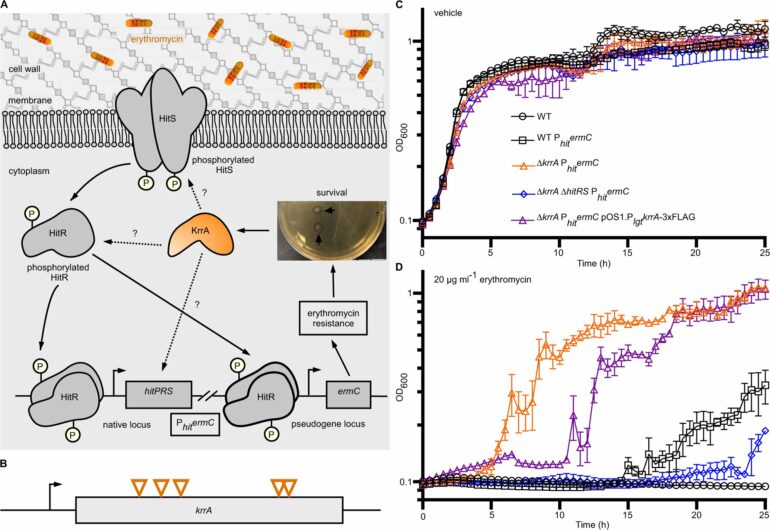Vanderbilt researchers have identified a critical regulatory factor in Bacillus anthracis, the bacterium that causes the disease anthrax and has been used as a biological weapon. The findings, reported in the journal Nature Communications, provide new insights into bacterial gene regulation and may guide novel antibacterial therapeutic strategies.
B. anthracis forms dormant spores—the infectious form of the bug—that can survive in the environment for decades. Although rare in the U.S., B. anthracis is found in soil around the world and causes severe disease in livestock, wild animals and people.
It is considered one of the most likely agents to be used for bioterrorism, because of the long-lived spores that can be released without detection, for example in powders, sprays, food or water. In 2001, powdered B. anthracis spores mailed in letters in the U.S. caused anthrax in 22 people; five of them died.
Like other bacteria, B. anthracis has evolved systems that enable its survival and multiplication in the hostile host environment. These “two-component systems” (TCSs) include a sensor protein that detects stress and a responder protein that alters gene expression to cope with the stressor. Some TCSs also have other modulator proteins.
“Two-component systems are prevalent in bacteria, but they are absent in humans and animals, which makes them attractive targets for developing novel antibacterial agents,” said Eric Skaar, Ph.D., MPH, Ernest W. Goodpasture Professor of Pathology, Microbiology and Immunology and director of the Vanderbilt Institute for Infection, Immunology and Inflammation.
Skaar’s team previously characterized the B. anthracis TCS called HitRS, which responds to disruptions of the cell envelope (the protective outer layers of the bacterium). It was unclear, Skaar said, how HitRS signaling is regulated to ensure response specificity in times of cell envelope damage.
Postdoctoral fellow Hualiang Pi, Ph.D., led studies to search for regulators of HitRS. Using an unbiased genetic selection strategy, the researchers identified a regulatory protein they named KrrA. They found that KrrA functions as an RNA-binding protein that binds to the HitRS messenger RNA (mRNA, the “expressed” form of the gene that is ready to be translated into protein) and modulates its stability.
KrrA appears to have functions broader than HitRS regulation, they discovered.
“We found that KrrA also binds to more than 70 other RNAs, and directly or indirectly affects the expression of over 150 genes involved in processes including genetic competence, sporulation, RNA turnover, DNA repair, transport and cellular metabolism,” said Pi, first author of the study.
KrrA did not exhibit RNA-degrading activity, and the mechanism it uses to modulate mRNA stability remains unclear, Pi said.
“Understanding how B. anthracis senses and responds to external threats could allow us to target these systems for the development of new antibiotics. If we can prevent B. anthracis from defending itself, we can make it easier to kill, which could make anthrax easier to treat,” Skaar said.
More information:
Hualiang Pi et al, An RNA-binding protein acts as a major post-transcriptional modulator in Bacillus anthracis, Nature Communications (2022). DOI: 10.1038/s41467-022-29209-4
Provided by
Vanderbilt University
Citation:
Study advances understanding of bacterial bioterrorism agent (2022, April 8)



